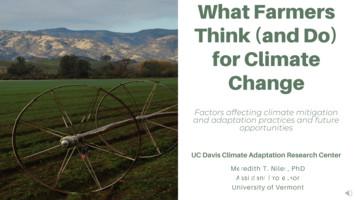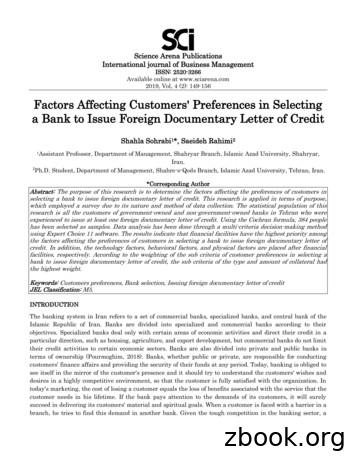Factors Affecting Climate
Lesson #14 (Climate)Worksheet #7Factors Affecting ClimateFactors that Affect TemperatureFactors that Affect PrecipitationLatitude: As latitude increases, theaverage yearly temperature decreases.Latitude: Belts of Low Pressure at 0ºand at 60º North and South latitudesproduce heavy precipitation. Belts ofHigh Pressure centered at 30º Northand South latitudes produce dryclimates and deserts.Proximity to large bodies of water:Areas near large bodies of water havea smaller range in temperaturevariations throughout the year. Areasfar from water have larger variations intemperature throughout the year.Proximity to large bodies of water:Areas near large bodies of water tendto have higher than average levels ofprecipitation, especially on the leewardside of the water.Location on Land Masses: Locationsnear the center of a large landmasstend to have wide ranges intemperatures both between day andnight, and seasonally.Location on Land Masses: Locationshear the center of a large landmasstend to have drier climates incomparison to locations near water.Location near mountain ranges:Windward sides are cooled whileleeward sides are warmed.Location near mountain ranges:Windward sides of mountains tend toreceive higher than averageprecipitation; leeward sides ofmountains tend to receive lower thanaverage precipitation.Elevation: As elevation increases, theaverage yearly temperatures decrease.Prevailing Wind Direction: Globalwind patterns determine the windwardand leeward sides of both mountainranges and bodies of water.Ocean Currents: Ocean currents tendto warm temperatures of easterncoastal areas and cool western coastalareas.Use the information on this page to complete the activity on the nextpage.1
Lesson #14 (Climate)Worksheet #7Factors that affect climate activity #1As you know, climate is determined by the temperature and the precipitationcharacteristics of a region over time. The temperature characteristics of a regionare influenced by natural factors such as latitude, elevation, and the presence ofocean currents. The precipitation characteristics of a region are influenced byfactors such as proximity to mountain ranges and prevailing winds. These too, arenatural factors that influence temperature.The temperatures and precipitation of a region remain relatively unchanged forthousands of years. Changes in climate are very gradual. Various years throughouthistory may be noted for being particularly hot, cold, wet or dry, but when manyyears are considered, these wild fluctuation in climate combine with manyrelatively “normal” years to develop a picture of the average climatecharacteristics of a region over time.Objectives:To identify the factors that affect the climate of a region;To identify and analyze the effects that various factors have on the climateof a hypothetical region of the globe.Procedure:1) Use the table of factors that influence climates above and an atlas to answerthe questions in the analysis and comprehension section which refer to thediagram. The diagram represents an imaginary continent on the Earth surroundedby water. The arrows indicate the direction of the prevailing winds. The large mountain ranges are also indicated. Points A, B and E are located at sea level: points C and D are in thefoothills of the mountains. Point F is high in the mountains.Map:Please look at the map on the next page and determine the climates of thelocations A - F. Then use the factors that affect climate to answer the questionsthat follow.2
Lesson #14 (Climate)Worksheet #73
Lesson #14 (Climate)Worksheet #7Analysis and Comprehension:1) What is the direction of the wind in the region:a) Above and below 60º North latitude?b) Above and below 60º South latitude?c) Between 60º and 30º North and South Latitude?d) Between 30º North and South Latitudes and the equator?2) What could be the reason for the change in wind directions?3) GIve the locations of the 2 mountain ranges.4) Which city probably has the same type of weather year round? Why?a) Use an atlas, globe, or the map in your textbook on page to find areal city in a similar location on Earth. What is that city?5) What factor would cause location F to have a colder yearly climate than anyother location?a) Use an atlas, globe, or the map in your textbook on page to find areal city in a similar location on Earth. What is that city?6) What 3 factors would cause location E to have the greatest annual rainfall?a) Use an atlas, globe, or the map in your textbook on page to find areal city in a similar location on Earth. What is that city?4
Lesson #14 (Climate)Worksheet #77) Which location, C or D, would you expect to have the greatest annual rainfall ofthe two? Explain your rationale.a) Use an atlas, globe, or the map in your textbook on page to find a two realcities in a similar location on Earth. What are those cities?8) Which location, A or B would you expect to have the greater range intemperature during the year? Explain your rationale for that answer.a) Use an atlas, globe, or the map in your textbook on page to find a two realcities in a similar location on Earth. What are those cities?9) Location A is in the center of a large desert. What factor could account for itslow annual precipitation?a) Use an atlas, globe, or the map in your textbook on page to find a real cityin a similar location on Earth. What is that city?10) What 3 factors would cause the climate in location D to be cooler than atlocation B?a) Use an atlas, globe, or the map in your textbook on page to find a real cityin a similar location on Earth. What is that city?5
Lesson #14 (Climate)Worksheet #7Tilt of the EarthThe tilt of the Earth is an important factor is creating different climate zones aswell as the Seasons. The primary reason for the different climates in relation tothe Earth is because the Earth is round, and tilted. This creates the unevenheating of the Earth.1.According to the image of the tilted Earth, which season do you think NorthAmerica is experiencing? Explain your answer.2. Draw where the tropical zone is. Describe how you know where it is?3. Based on the image, the South Pole (Antarctica) is pointing slightly towards thesun. However, it still remains a frozen place. Why do you think this occurs?4.The Earth is tilted at a 23.5 angle. If this angle increased to 45 , how do youthink the Earth’s climates would be affected?6
Lesson #14 (Climate)Worksheet #75. In approximately six months from today, South America will be experiencingwhich season? Explain.6. You just received a text from your friend Tasha who is planning a vacation inBrazil in 3 months, but she is unsure on what kind of clothes to pack. Offersuggestions with appropriate rationale.7. England historically has a milder temperature and climate than its neighbors.How can this be explained? (Hint - look at how the Coriolis Effect moves wateraround).8.A rubber duck has been tossed overboard off the coast of Peru. Describe hisjourney BACK to Peru, including the direction of the ocean currents, the movementof the water due to the Coriolis Effect, and the various climates encountered.7
Lesson #14 (Climate) Worksheet #7 Factors that affect climate activity #1 As you know, climate is determined by the temperature and the precipitation characteristics of a region over time. The temperature characteristics of a region are influenced by natural factors such as latitude, elevation, and the presence of ocean currents.
Drugs Affecting Autonomic Nervous System, 2. Drugs Affecting Central Nervous System, 3. Drugs Affecting Cardiovascular System, 4. Drugs Affecting Haemostasis and Thrombosis, 5. Drugs Affecting Renal Function, 6. Drugs Affecting Endocrine System, 7. Drugs Affecting Respiratory System, 8. Drugs Affecting Gastr
Factors affecting adoption What practices have they adopted (or want to? Policy design and opportunities. Davidson, D. Nature Climate Change volume6, pages433–435 (2016) FACTORS AFFECTING CLIMATE BEHAVIORS Belief/perceptions Knowledge Capacity Social networks Environmental factors
on Construction Crew Productivity, and this list highlights 16 factors affecting labor productivity. 6.1 Labor Factors Here are some of the most recognized factors affecting labor productivity in the industry: 1. Overtime Scheduling of extended work days or weeks exceeding a standard eight-hour work day or 40-
Factors Affecting Customer Preferences Identifying the factors affecting customers' preferences in purchasing an investment deposit product and determining priorities of factors such as behavioral and attitudinal, techn
mix were predominantly the major factors influencing the consumers ¶ decision to buy. These was based on durable goods, such as televisions fridge, motor vehicle and etc. Kotler and Armstrong (2007) conducted a research to study factors affecting consumer buying behavior. Amongst all the factors, physical factors, social factors, cultural factors
FACTORS AFFECTING THE DESIGN TIDCKNESS OF BRIDGE SLABS: DESIGN AND PRELIMINARY VERIFICATION OF TEST SETlTP by J. H. Whitt,J. Kim, N. H. Burns, andR. E. Klingner Research Report Number1305·1 Research Project 0-1305 Factors Affecting Design Thickness ofBridge Slabs conducted for the TEXAS DEPARTMENT OF TRANSPORTATION in cooperation with the
Factors Affecting EV Adoption . The factors affecting EV adoption are organized as those that are internal to EVs, like battery performance and price and those that are external, such as fuel prices and charging stations, and the policy mechanisms that may influence adoption.
A. Thomas Perhacs is the author, creator, and visionary behind the Mind Force Method. He is also the President of Velocity Group Publishing and Director of The























